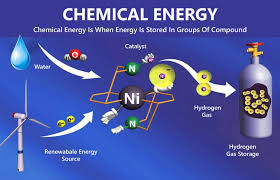How Chemical Energy Transforms into Electrical Energy
Description:
Delve into the fascinating world of chemical energy, the potential energy stored within the bonds of chemical compounds. This article explores the fundamental nature of chemical energy, how it’s released and harnessed, and critically, its pivotal role in the conversion from chemical energy to electrical energy.
We’ll examine various technologies, from everyday batteries to large-scale power plants, and discuss the efficiency, environmental implications, and future prospects of this ubiquitous energy form. If you’re looking to understand how the power in fuels, food, and batteries translates into the electricity that powers our lives, this guide provides top-rated insights and recommendations.
Introduction to the Ubiquitous Force: Chemical Energy
In the grand tapestry of energy forms that govern our universe and daily lives, chemical energy holds a unique and foundational position. It is the silent, stored power within the very structure of matter, waiting to be unleashed through chemical reactions. From the explosion of a firework to the slow burn of food in our bodies, from the charge held in a smartphone battery to the immense power generated by burning fossil fuels, chemical energy is an omnipresent force.
For users particularly interested in how this form of energy relates to “electrical energy,” understanding the principles, applications, and especially the conversion processes from chemical energy to electrical energy is crucial. This article aims to illuminate the world of chemical energy, explore its diverse manifestations, and provide top-rated recommendations and insights into its transformation into the electrical power that drives modern civilization.
Understanding Chemical Energy at its Core
At its most fundamental, chemical energy is a form of potential energy stored within the bonds of chemical compounds – the connections between atoms and molecules. Atoms are held together by chemical bonds, and these bonds possess varying amounts of energy. When a chemical reaction occurs, these bonds can be broken, and new bonds can be formed.
-
Energy Release (Exothermic Reactions): If the newly formed bonds in the products are stronger and more stable (containing less energy) than the bonds in the reactants, the excess energy is released, often as heat and/or light. This is an exothermic reaction. The combustion of wood or natural gas are classic examples.
-
Energy Absorption (Endothermic Reactions): Conversely, if the products have weaker, less stable bonds (containing more energy) than the reactants, energy must be absorbed from the surroundings for the reaction to occur. This is an endothermic reaction, like photosynthesis, where plants use sunlight to convert carbon dioxide and water into glucose (stored chemical energy).
The amount of chemical energy a substance possesses depends on its chemical composition, structure, and the specific arrangement of its atoms. Substances like fuels (gasoline, coal, wood), food (carbohydrates, fats, proteins), and battery materials are rich in chemical energy precisely because their molecular structures allow for significant energy release upon transformation.

The Critical Transformation: From Chemical Energy to Electrical Energy
One of the most vital and impactful applications of chemical energy is its conversion into electrical energy. Electricity is a highly versatile and convenient form of energy, but it often originates from a primary source of chemical energy. This transformation can occur through several mechanisms, broadly categorized into direct and indirect conversion.
1. Direct Conversion of Chemical Energy to Electrical Energy: Batteries and Fuel Cells
Direct conversion methods transform chemical energy into electrical energy without an intermediate thermal or mechanical stage, often leading to higher theoretical efficiencies.
-
Batteries: The Workhorses of Portable Chemical Energy
Batteries are electrochemical devices that directly convert stored chemical energy into electrical energy through redox (reduction-oxidation) reactions. A typical battery consists of:-
Anode (Negative Electrode): Where oxidation occurs (loss of electrons).
-
Cathode (Positive Electrode): Where reduction occurs (gain of electrons).
-
Electrolyte: A medium that allows ions to flow between the anode and cathode but prevents direct electron flow.
-
Separator: A physical barrier preventing the anode and cathode from touching, which would cause a short circuit.
When a battery is connected to an external circuit, chemical reactions at the anode release electrons, which flow through the external circuit (powering a device) to the cathode. Simultaneously, ions move through the electrolyte to maintain charge balance.
-
Primary Batteries (Non-rechargeable): The chemical reactions are irreversible. Once the reactants are consumed, the battery is “dead.” Examples include alkaline batteries (AA, AAA) used in remote controls and zinc-carbon batteries.
-
Recommendation: Best for low-drain devices where long shelf life is needed.
-
-
Secondary Batteries (Rechargeable): The chemical reactions can be reversed by applying an external electrical current, restoring the reactants. Examples include:
-
Lead-Acid Batteries: Used in cars for starting, lighting, and ignition (SLI). Relatively low energy density but high surge current.
-
Nickel-Cadmium (NiCd) & Nickel-Metal Hydride (NiMH): Older rechargeable technologies, largely superseded by Li-ion in many applications but still found in some power tools and hybrid vehicles.
-
Lithium-ion (Li-ion) Batteries: Dominant in portable electronics (smartphones, laptops) and electric vehicles (EVs) due to their high energy density, light weight, and long cycle life. Various chemistries exist (LFP, NMC, NCA), each with trade-offs.
-
Top Recommendation for Modern Electronics & EVs: Li-ion technology currently offers the best balance of performance for most portable and high-demand applications.
-
-
-
-
Fuel Cells: Continuous Chemical Energy Conversion
Fuel cells are similar to batteries in that they convert chemical energy directly into electricity via electrochemical reactions. However, unlike batteries, fuel cells require a continuous supply of fuel (like hydrogen, natural gas, or methanol) and an oxidant (usually oxygen from the air) from an external source to operate. As long as fuel and oxidant are supplied, the fuel cell will produce electricity, water, and heat.-
Proton Exchange Membrane Fuel Cells (PEMFCs): Use hydrogen as fuel and operate at relatively low temperatures. Promising for transportation and portable power.
-
Solid Oxide Fuel Cells (SOFCs): Operate at high temperatures, allowing them to use various hydrocarbon fuels directly. Suitable for stationary power generation and auxiliary power units.
-
Recommendation: Ideal for applications requiring continuous, clean power where a fuel source is readily available. Hydrogen-powered PEMFCs are a top contender for future zero-emission transport.
-
-
The direct conversion of chemical energy to electrical energy in batteries and fuel cells is a cornerstone of modern technology, enabling portability and, in the case of fuel cells, potentially highly efficient and clean energy generation.
2. Indirect Conversion of Chemical Energy to Electrical Energy: Thermal Power Plants
The most common method for large-scale electricity generation involves an indirect pathway: chemical energy is first converted into thermal energy (heat), then into mechanical energy, and finally into electrical energy.
-
Combustion-Based Power Plants:
These plants burn fuels rich in chemical energy – such as coal, natural gas, oil, or biomass – in a boiler.-
Chemical to Thermal: The combustion process is an exothermic reaction that releases the stored chemical energy as heat.
-
Thermal to Mechanical: This heat is used to boil water, producing high-pressure steam. The steam expands and drives the blades of a turbine, converting thermal energy into rotational mechanical energy.
-
Mechanical to Electrical: The rotating turbine is connected to a generator. The generator uses the principle of electromagnetic induction (rotating a coil of wire in a magnetic field or vice-versa) to convert mechanical energy into electrical energy.
-
Coal-Fired Power Plants: Historically a backbone of electricity generation, but face significant environmental concerns due to CO2 emissions and other pollutants.
-
Natural Gas Power Plants: Generally cleaner than coal (lower CO2, SOx, and NOx emissions per unit of energy) and can be more flexible (quicker to start up and ramp down). Combined Cycle Gas Turbines (CCGT) are particularly efficient.
-
Biomass Power Plants: Burn organic materials (wood, agricultural waste). Can be carbon-neutral if biomass is sustainably sourced, as the CO2 released during combustion was previously absorbed during plant growth.
-
Recommendation: While historically dominant, reliance on fossil fuel combustion is decreasing due to climate change. Natural gas plants offer a transitional solution, while sustainable biomass can be part of a renewable mix.
-
-
This indirect route, while well-established and capable of producing vast amounts of electricity, typically has lower overall efficiencies (30-60%) compared to the theoretical potential of direct conversion methods, due to thermodynamic losses at each conversion stage, primarily as waste heat.
Diverse Applications of Chemical Energy Beyond Electricity Generation
While the conversion to electrical energy is a key focus, chemical energy powers countless other aspects of our lives:
-
Transportation: The internal combustion engines (ICEs) in cars, trucks, ships, and airplanes predominantly run on the chemical energy stored in gasoline, diesel, and jet fuel. Combustion within the engine cylinders converts this chemical energy into mechanical energy to propel the vehicle.
-
Heating: Burning natural gas, heating oil, propane, or wood in furnaces and boilers provides chemical energy converted to heat for homes, businesses, and industrial processes.
-
Industrial Processes: Many industries rely on chemical energy from fuels for high-temperature processes like smelting metals, producing cement, or manufacturing chemicals.
-
Biological Systems: All living organisms, including humans, depend on chemical energy stored in food (carbohydrates, fats, proteins). Metabolism is a complex series of chemical reactions that break down food molecules, releasing energy (primarily in the form of ATP – adenosine triphosphate) to power cellular activities, muscle movement, and maintain body temperature.
-
Explosives and Propellants: Substances like gunpowder or dynamite store a large amount of chemical energy that can be released very rapidly, creating a powerful explosion or propelling a rocket.
The Efficiency and Environmental Footprint of Harnessing Chemical Energy
The way we harness and utilize chemical energy has significant implications for efficiency and the environment.
-
Efficiency: The efficiency of converting chemical energy into useful work or other energy forms varies greatly. For instance, modern Li-ion batteries can have charge/discharge efficiencies exceeding 90%. High-efficiency CCGT power plants can reach around 60% electrical efficiency. In contrast, traditional internal combustion engines in cars typically operate at around 20-35% efficiency, with much of the chemical energy in fuel lost as waste heat.
-
Environmental Impact:
-
Fossil Fuels: The combustion of coal, oil, and natural gas is a major source of greenhouse gas emissions (primarily CO2), contributing to climate change. It also releases pollutants like sulfur oxides (SOx), nitrogen oxides (NOx), and particulate matter, which affect air quality and human health.
-
Batteries: While the operation of batteries is clean at the point of use, their production (mining of lithium, cobalt, nickel) and disposal can have environmental consequences. Recycling efforts are crucial to mitigate these impacts.
-
Fuel Cells: Hydrogen fuel cells produce only water as a byproduct, making them very clean at the point of use. However, the environmental impact depends on how the hydrogen fuel is produced. “Green hydrogen” (produced via electrolysis using renewable electricity) is the ideal, while “grey hydrogen” (from natural gas reforming) still has a carbon footprint.
-
Biomass: Sustainable biomass can be a low-carbon source of chemical energy, but unsustainable harvesting can lead to deforestation and biodiversity loss.
-
The pursuit of cleaner and more efficient ways to utilize chemical energy, especially for conversion to electrical energy, is a critical global challenge.
The Future of Chemical Energy: Innovations and Directions
The field of chemical energy is continuously evolving, driven by the need for greater efficiency, sustainability, and new functionalities.
-
Advanced Battery Technologies: Research is booming in areas like solid-state batteries (promising higher energy density and safety), lithium-sulfur batteries, and sodium-ion batteries (using more abundant materials). These could revolutionize EVs, grid-scale energy storage, and portable electronics.
-
The Hydrogen Economy: Green hydrogen, produced using renewable electricity to split water, is envisioned as a key energy carrier. This chemical energy in hydrogen can then be converted to electrical energy in fuel cells for transport, industry, and power generation, or burned directly for heat.
-
Sustainable Biofuels and Synthetic Fuels (E-fuels): Advanced biofuels from algae or waste, and e-fuels (synthetic hydrocarbons produced using renewable electricity and captured CO2) offer pathways to decarbonize sectors like aviation and shipping where direct electrification is challenging. They store solar or wind energy in chemical bonds.
-
Carbon Capture, Utilization, and Storage (CCUS): For processes that still rely on combusting fossil fuels, CCUS technologies aim to capture CO2 emissions. The captured CO2 can then be stored underground or utilized to create products, including synthetic fuels, effectively recycling the carbon and storing renewable energy as chemical energy.
-
Improved Catalysts: Catalysts are crucial for many chemical reactions, including those in fuel cells and industrial processes. Developing more efficient, durable, and cheaper catalysts can significantly enhance the performance and economic viability of chemical energy conversion technologies.
The future will likely see a more diverse and integrated energy system where chemical energy plays a synergistic role with other energy forms, particularly renewables, facilitating storage and transport of energy.
Conclusion: The Enduring Power of Chemical Energy
Chemical energy is an indispensable cornerstone of our energy landscape. From the fundamental reactions that sustain life to the complex technologies that power our modern world, its influence is pervasive. The ability to convert chemical energy to electrical energy with increasing efficiency and reduced environmental impact is paramount as we navigate the transition to a more sustainable future. Batteries are empowering a mobile, electrified society, while fuel cells offer a tantalizing glimpse into clean, continuous power. Even traditional thermal power plants are evolving, with a shift towards cleaner fuels and carbon capture.
As research continues to unlock new materials, innovative processes, and more efficient conversion pathways, the role of chemical energy will undoubtedly adapt and expand. Whether it’s in next-generation batteries, the burgeoning hydrogen economy, or novel synthetic fuels, chemical energy will remain a critical component in meeting global energy demands, driving technological advancement, and shaping a more sustainable and electrified tomorrow. Its silent potential, locked within molecular bonds, continues to be one of humanity’s most valuable and versatile resources.




